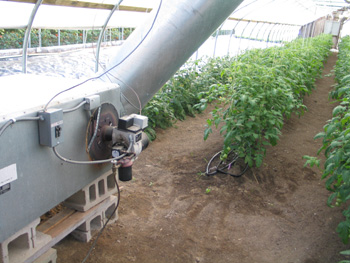Heating fuel prices have been volatile over the past few years. How high they may go in the future will depend on many factors including the world fuel supply situation, demand, level of inflation and the weather. Good energy conservation measures can help to offset this increase and keep production costs under control.
Keeping the greenhouse heating system in peak operating condition is a good starting point. It can save by increasing efficiency, providing more uniform temperature in the growing area, reducing service calls and letting you sleep through the night.
Fuel
Protect fuel tanks. Twenty percent of all service calls result from dirty fuel or problems related to the flow of the fuel. Tanks should be located away from dusty locations and water tight fittings should be used. Outdoor tanks should be protected from harsh winter weather with an enclosure.
Have all heating units serviced before winter. The efficiency of most greenhouse heating systems can be improved by at least 5 percent. A first step towards this is to have a competent service person clean and adjust all furnaces and boilers before the start of the heating season. This should include:
Oil furnace servicing
- Change the fuel filter on oil furnaces. It is surprising how much sludge and dirt collects in the fuel.
- Replace the nozzle. Wear increases the nozzle orifice opening, increasing fuel usage. Select a nozzle with the correct spray angle to fit the firebox. Follow the manufacturers’ recommendations.
- Replace and adjust electrodes.
- Inspect safety controls including flame detector cell sensor, transformer, limit switch and fan control.
Gas furnace servicing
- On natural gas units, check gas inlet and manifold pressure to make sure it is properly set.
- On propane units check gas regulators for proper pressure settings and to be certain the regulator and gas port vents are not plugged
- Tank relief valves should be replaced every 5 to 10 years.
- On larger systems an evaporator or vaporizer converts the liquid propane into the gaseous state. These heaters with safety valves and flame supervisor need to be checked and maintained
- The mixer, a valve which combines propane gas with atmospheric air, should be serviced and tested to manufacturers’ recommendations.
- It’s a good idea to operate the furnace on a monthly basis during the year to check for problems.
Heat exchanger
- Soot should be removed from heat exchanger surfaces. A 1/8-inch soot deposit can increase fuel consumption by as much as 10%. Brush and vacuum surfaces or clean them with special cleaning compounds.
- Exterior heat exchange surfaces, such as tubes, fins and radiators, collect considerable dust and dirt in a greenhouse atmosphere. Brush and vacuum surfaces to increase heat output.
- Clean blowers for efficient air movement.
- Drain off dirty water in steam and hot water systems. Analyze boiler water periodically to determine if treatment is needed.
Combustion Efficiency
Efficiency testing of a furnace or boiler is a 10-minute procedure that can indicate when problems begin to occur. It is the key to saving money on the heating bill. Increasing efficiency one or two percent can significantly reduce fuel consumption over the year. For example, a 2% increase in efficiency of a million Btu/hr burner operating 3300 hours from September to May will save about 650 gallons of fuel oil. This estimate is based on efficiency tests conducted on greenhouse heating equipment in Connecticut and Massachusetts.
Combustion Air
The combustion process combines the carbon in the fuel with the oxygen in the air. The lack of adequate oxygen results in incomplete combustion and carbon buildup. A 400,000 Btu/hr furnace will require about 100 cubic feet of air/minute to operate efficiently. In tight poly and glass greenhouses, a makeup air supply of 1 square inch of intake area/2,000 Btu/hr burner input should be available from a pipe or louver through the endwall unless a separated-combustion heater is installed. These are installed with a direct connection to outside air.
Flue pipe connections should be tight and the chimney should extend at least 2 feet above the ridge of the greenhouse. The top of the chimney should be at least 8 feet above the combustion chamber and have a cap to prevent backdrafts and possible air pollution injury to plants. Consider installing a forced convection system to expel the combustion gasses.
Controls
Accurate controls are important to achieve high efficiency. The payback of replacing an old mechanical thermostat with a new electronic thermostat having a +/- 1 degree F differential is very short. The sensor should be shielded and aspirated with a small fan to quickly sense changes in the environment.
Heat Distribution
Air circulation will reduce temperature stratification in the greenhouse. Installing horizontal air flow (HAF) fans that move the air at 50 to 100 cubic feet/minute (cfm) can limit temperature differences to no more than 2 degrees at any point in the growing area; an overall capaity of 3 cfm per square foot of greenhouse/growing area is recommended. Use 1/10th horsepower circulating fans located 40 to 50 feet apart to create a circular flow pattern.
Additional Resources for Greenhouse Energy Conservation and Efficiency
Introduction to Greenhouse Efficiency and Energy Conservation
Contributors to this Article
Authors
- John Bartok, Jr., Agricultural Engineer, University of Connecticut
- Vern Grubinger, Professor, University of Vermont Extension
Peer Reviewers
- Tina Smith, University of Massachusetts
- A.J. Both, Rutgers University

